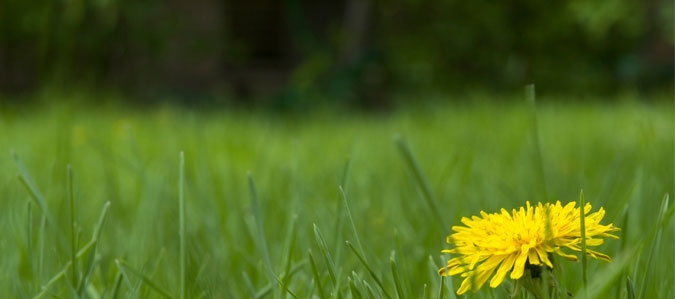How to Prepare Your Lawn For Winter

You want your lawn to be flawless – just the right height, the perfect shade of green and no brown patches in sight. As the end of the year creeps near, you always dread the winter months and what they do to your lawn. But the issue might not be the cold weather, snow and ice. It may be because you do not know the best ways to prepare your lawn for winter.
Midwestern winters can be harsh. From plenty of snow and ice to average winter temperatures below freezing, plenty of factors can contribute toward winter lawn damage. Prepare your yard for the cold season with Indiana winter lawn care tips.
Protecting Your Lawn From the Winter Weather
As fall sets in, nature puts on a magnificent display of farewell from long days and hot sunny weather. Temperatures dip and early morning dew begins to appear on your lawn as daylight gets shorter. It’s easy to forget about your grass when brilliant red and gold leaves cover the green that’s beginning to return to your yard after summer’s harsh browning.
But fall is not the time to neglect your lawn maintenance. Indeed, the shoulder months of September, October and November are the peak period where your grass needs you most. Most people think of holidays and football as winter approaches. Winterizing your lawn might not seem like a priority. However, knowing how to protect your lawn in the winter is crucial. Fall is the time when grass takes a leap of activity as it prepares to go dormant.
Lawn care in the fall can make it or break it for spring. Spring yard care usually gets the most attention, but knowledgeable groundskeepers and homeowners know that fall is a time to look ahead towards spring and prepare your lawn.
Protecting your lawn in the fall has the highest return for long-term, year-round grass health. Lower light, cool fall temperatures and higher rainfall are nature’s signals for grass to begin a final growth period before nodding off to sleep under a white blanket of snow. That’s when your lawn needs protection.
The Importance of a Healthy Lawn
A healthy lawn doesn’t happen on its own. Bright, luscious lawns come from special attention given by caring keepers over the entire year’s cycle. That involves nurturing, feeding and protecting grass from disease, insects, drought and damage from all sorts of threats. Protecting your lawn and preparing it for winter is vital to its survival and prosperity. It starts with appreciating a healthy lawn’s value.
Lawns are an essential landscape feature. There’s nothing like a healthy green glow and the unmistakable smell of freshly cut grass that shines and wafts about your front and backyard. Aesthetically, lawns do wonders to enhance your spirit and help with social harmony. They complement other plantings and earn verbal compliments over the fence from neighbors who admire and appreciate your lush, thriving grass.
Lawns contribute more than personal and neighborhood pride. They come with various other benefits, sealing the deal on the importance of a healthy lawn.
- Increase property value: Healthy lawns, combined with ornamental plantings like trees, shrubs and beds, add significant value to your property. Nothing makes a better overall curb appeal statement than a well-cared-for property, which includes a healthy, manicured lawn.
- Benefit the environment: Your lawn is excellent for the environment. Active, healthy yards act as air scrubbers, taking in carbon dioxide and filtering pollutants. Grass, like other growing plants, releases oxygen back into the air, making it an essential part of the ecosystem.
- Reduce noise pollution: Lawn areas significantly contribute to sound reduction. Noise pollution is a significant issue in urban areas. Grass has a tremendous ability to absorb sound, whether it’s a high-pitched whine from an overhead plane or the low rumble of a passing truck. Lawns muffle human conversation, as well. That’s why so many enjoy spreading out on the grass for a picnic or contemplating the world quietly.
- Protect from soil erosion: On a practical side, lawns are a primary defense against soil erosion. Growing a blanket of grass ensures topsoil doesn’t get lost in water runoff or blown away by exposure to dry winds. Lawns act as an insulator to prevent groundwater evaporation. That’s self-serving, as the grass’ roots need to absorb stored water, whether it’s natural from rain or artificial through irrigation.
- Cool the temperature: In city sites, lawns do a marvelous job of mitigating heat. Just think of the difference between walking bare fee in mid-day July on pavement versus cutting across the yard. Urban heat dissipation is a severe problem in many areas, and your healthy lawn does its part to cool the neighborhood.
- Provide safety: Lawns provide security by creating distinct open zones where high visibility deters unwelcome intruders. Healthy lawns even serve as natural firebreaks.
What Happens to Your Lawn in the Winter?
You’ll hear the expression that lawns die off in the winter and experience a rebirth in the spring. There’s a myth that grass is completely dead with no signs of life while the ground is frozen and covered with feet of snow and ice. Then, like magic, once the thaw happens, bare grass on the surface somehow has a comeback and begins its lifecycle again.
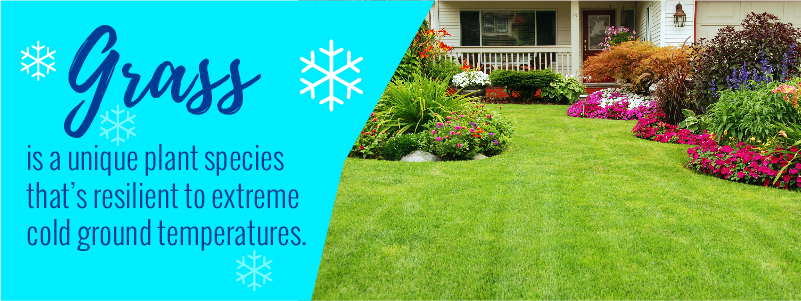
A rhizome is a crucial component of your grass plants. You might say it’s their “brain”, or at least their communication center. They sit slightly below the soil surface and join the blades to the roots. Rhizomes are stems that grow sideways and produce both blades and roots. They mitigate what’s going on above and below the surface. They are also directly responsible for overall plant health.
It’s fair to say that above-ground grass blades die off in the winter. They’re gone and rot or decay like other expired organic material. But just below ground — even though they’re frozen and inert — your lawn’s rhizomes and roots are very much alive. They’ve only turned dormant. That’s the way grass has evolved to handle harsh winter conditions. It can survive and perennially come to life in the spring if you follow Indiana winter lawn care tips
Understanding Lawn Winterizing
You can help prepare your lawn for winter by understanding what’s happening as it cycles through fall. In most areas across America, lawns prosper in the spring with rapid, ambitious growth. As summer heats up and dries out, grass enters a natural semi-dormant phase where it naturally conserves energy and water. But as fall begins, your grass starts preparing itself for hibernation by storing energy in the rhizomes and roots.
That’s why you’ll see the green come back in the fall with new growth. It’s stocking up for the winter, and this is when it needs your help to prepare. If you ask most lawn care professionals, they’ll tell you to spend more time protecting your yard in the fall, rather than getting overly fussy in the spring.
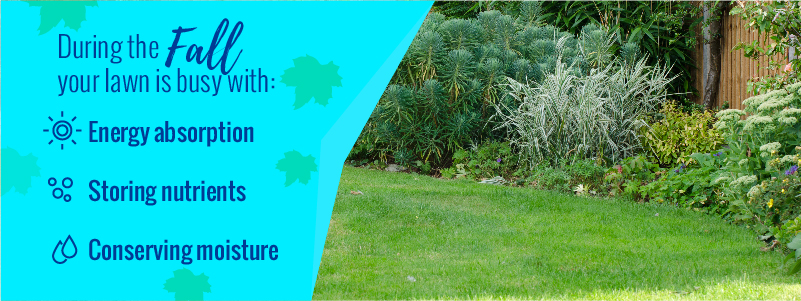
It’s a myth that just because yards seem to grow more slowly in the fall than the spring, they need less care come winter. The opposite is true. During the fall, your lawn is busy with energy absorption, storing nutrients and conserving moisture.
Helping your lawn to survive the winter and flourish every spring requires a commitment and attention to detail. It’s about understanding the growing process and what your lawn requires at each stage to remain healthy. Fortunately, many people with extensive lawn care expertise are happy to share that information with you.
Common Winter Lawn Issues
Before you can learn how to prevent a dead lawn in the winter, you need to know what your grass will undergo. Your yard may face a few common winter lawn issues, including these.
- Footprints: Cold weather freezes the liquid-filled cells of grass blades. That means when you step on them, they shatter, rather than absorbing the impact. With broken cells, grass blades die, and you’ll see dead spots that resemble footprints once the snow and ice melt away.
- Snow mold: Things might be frozen solid above the snow that blankets your grass. However, underneath, conditions are often wet and mild. Combine that with darkness, and you’ve got the perfect combination for mold growth. Snow mold has a cotton-like look to it, and the affected grass turns brown.
- Fungus: Fungi also thrive in a moist winter environment. Depending on the fungus that’s grown on your lawn, you may see evidence of disease and discoloration or patches and spots throughout your grass.
- Voles: These rodents love running around between your lawn and the snow on top. You may be able to recognize the paths they’ve taken throughout your yard by the winding, dead trails of grass.
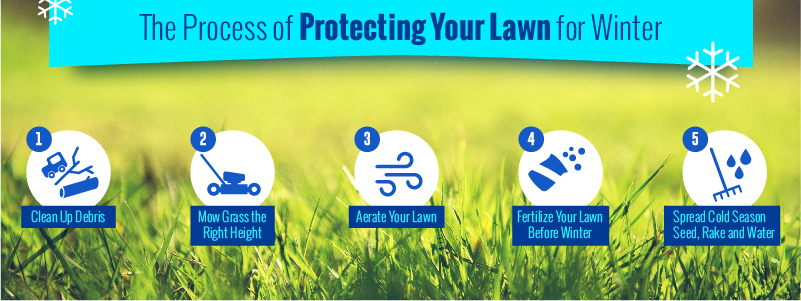
What Are the Causes of Winter Lawn Damage?
Your yard has a lot to face during the cold season that can cause winter lawn damage. Understand these threats to prepare yourself to prevent a dead lawn in the winter.
- Cold temperatures: Unsurprisingly, the cold during winter affects your lawn. Uncovered grass rather than grass under a blanket of snow has more exposure to the cold. That’s because snow acts as an insulator. Without snow, your grass gets colder and loses more moisture.
- Changing temperatures: Early and late winter often come with unpredictable temperatures. Things may warm up, luring your lawn into what seems like a warm season. Suddenly, the temperatures drop, and the fluctuations can cause grass to die.
- Walking across your lawn: If you can avoid it, use other walkways in your yard instead of walking on the grass. Walking across your frozen grass means you risk killing the blades.
- Snow and ice removal: If you plow your driveway or your lawn shares a border with a roadway that plows take care of, you may have bare patches left behind. Using chemicals to melt ice could also cause winter lawn damage.
The Process of Protecting Your Lawn for Winter
The process of preparing your lawn for winter is relatively straightforward. It’s a matter of understanding what natural responses your grass has and why it acts the way it does. There is a step-by-step procedure, with each step equally contributing to an overall healthy lawn.
But getting your lawn ready to survive the winter can be time-consuming. It’s also time-sensitive. Grass plants naturally respond to temperature and photosynthesis. Depending on your area and climate conditions, lawns need attention at a precise time in their lifecycle. The calendar date is somewhat irrelevant. Grass responds proportionately to daylight, coolness and relative humidity.
It’s handy to know the acronym SON. That stands for September, October and November. These are the fall months when dew starts in the morning and the first surface frost appears. Changing conditions trigger grass to prepare for a shutdown, and the first thing you’ll see is a spurt of growth and brightness in color. Now it’s time to begin protective work.
The first piece of advice is to work within your lawn’s critical time window. In most places, crucial timing is over a few weeks, not those three months. If you have a large yard area, consider contracting a maintenance company to prepare your lawn for winter properly. Experienced lawn professionals like those at Ricci’s Landscape Management have the knowledge, skills, materials and equipment to make your yard’s winter treatment easier and save your valuable time. They’ll also give you a healthier spring yard than you‘d get by working on your own.
If you want to DIY part of the process to prevent winter lawn damage, follow these steps.
1. Clean Up Debris
The first step in preparing for your yard’s winter journey is cleaning up debris. Large items like branches, logs, lawn furniture and kids’ toys left on the grass over winter have a devastating effect on grass health. Surface coverage blocks topside air and creates large dead spots come the spring.
Piled debris on your lawn can also cause snow mold, an organic contaminant that severely delays spring grass growth. It’s also a chore to remove and usually requires correcting the soil to a balanced pH state.
There’s a hot debate among homeowners and lawn maintenance professionals about leaves and needles. Both agree that fall tree droppings aren’t good for lawn health if left lying there over winter. They’re right, but there are two schools of thought on what to do.
Some groundskeepers opt for raking leaves and disposing of them in a landfill or compost piles. Others see great organic value in recycling leaves, just like they do with cut grass clippings. Many swear by spreading fallen leaves evenly, then chopping them into tiny pieces with a power mulcher. Doing so creates an excellent winter blanket that’s nutritious and free.
2. Mow Grass the Right Height
Here, we have another point of contention among grass maintainers. There’s a consensus your lawn should have consecutive mowings in the fall right up until snowfall. Most agree you should cut shorter in the spring and fall as a best practice.
However, they disagree on how long to leave your grass and what the right blade height should be. You need to leave various species of grass at different heights before winter. There’s a standard rule of thumb where you should never cut grass more than one-third of its standing height. That means 3-inch-tall grass should only have 1 inch removed, leaving the blade 2 inches tall.
Consult with a lawn maintenance company that knows your grass species and can cut it to the right winter height.
3. Aerate Your Lawn
Aeration is one of the best possible things you can do to care for your lawn and prepare it for winter. Aeration involves boring holes into the soil and leaving small plugs to dry and decompose on the yard’s surface. These portals to grass’ roots let water, air and fertilizer freely drain down to where they can do the most good.
Pre-winter conditioning is all about root building for lawns. You should do the aeration late in the fall, just before you make final cuts. Doing so lets the roots, rhizomes and blades recover from aeration trauma and set themselves up for dormancy.
Proper aeration takes knowledge and skill. It needs a precise, uniform pattern, as over-aeration can severely hurt your grass. Manual aerators are available, but they’re not effective for large areas. Power aerators from professional lawn maintenance companies are the best way to go.
4. Fertilize Your Lawn Before Winter
Once you’ve cleaned your yard of debris, cut and aerated it, it’s necessary to fertilize it before the cold and snow arrive. Fertilize your lawn after opening it up through aeration in order to give your lawn the essential nutrients it needs. This will ensure that the nutrients are absorbed into the lawn during the cold, dormant months. Proper fertilization takes knowledge and skill, just like all other steps in preparing your lawn.
Most homeowners are somewhat familiar with fertilizer ratings. These ratings are N for nitrogen, P for phosphorus and K for potassium. High–nitrogen fertilizers are great for the spring because they promote leafy vegetation growth. But that’s not what you want for your lawn in the fall. Phosphorus is the best material for supporting root and rhizome growth. Make sure to use a fertilizer with a high P-rating to help prevent a dead lawn in the winter.
Another word on fertilizers is that some are water-soluble and others are slow-release granular types. Most professionals recommend granular fertilizer high in phosphorus for winter preparation. If in doubt, get professional advice from Ricci’s Landscape Management — our experts know exactly what your lawn needs for the winter.
5. Spread Cold Season Seed, Rake and Water
It’s always wise to give your lawn new seed before winter. Blend cold season seed to germinate in cool soil and get a foothold before the entire yard goes dormant. Some seed blends are available with fertilizer and antifungal coatings. They can be hand-cast or applied with a spreader.
Make sure you give your fresh seeds sufficient time to sprout before winter sets them back. Two weeks before freezing is usually enough to let them root and start a short blade. When done within the entire winter preparation system of cleaning, mowing, mulching, aerating and fertilizing, there’s little left to do before winter.
All that’s left is a little raking to spread everything and a minimal amount of water to make sure your lawn is ready for its long winter nap. Make sure you blow out your irrigation lines if you have an automatic watering system. Clean and put away your tools, so they’ll be ready to do it all over in the spring.
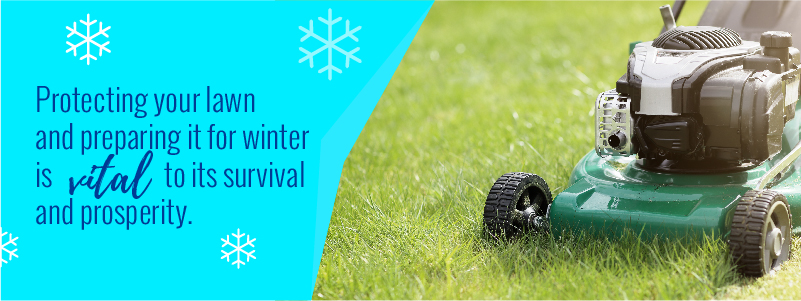
Contract With a Professional Lawn Maintenance Company for Your Winter Needs
Ricci’s Landscape Management is your trusted lawn maintenance partner and will properly prepare your grounds for the upcoming winter. For over two decades, RLM has given exceptional customer service and quality work to people in the Chesterton, Crown Point, Munster, St. John and Valparaiso areas.
We provide a wide range of landscape services, from protecting your lawn in the fall to designing and constructing some of the most stunning landscape features you can imagine. We build and maintain irrigation systems. We specialize in lawn fertilization through the seasons. RLM also provides outdoor lighting, and we even do mosquito control.
Something else that RLM, Inc. performs is winter snow and ice clearing and removal. Our service includes snow plowing, sidewalk shoveling, snow blowing, and sidewalk de–icing. Sign up now for full-service landscape maintenance and snow management.
Year-round, we’re here to help you have healthy lawns and safe walks. Call RLM today at 219–996–2682 or contact us online to request a quote.






